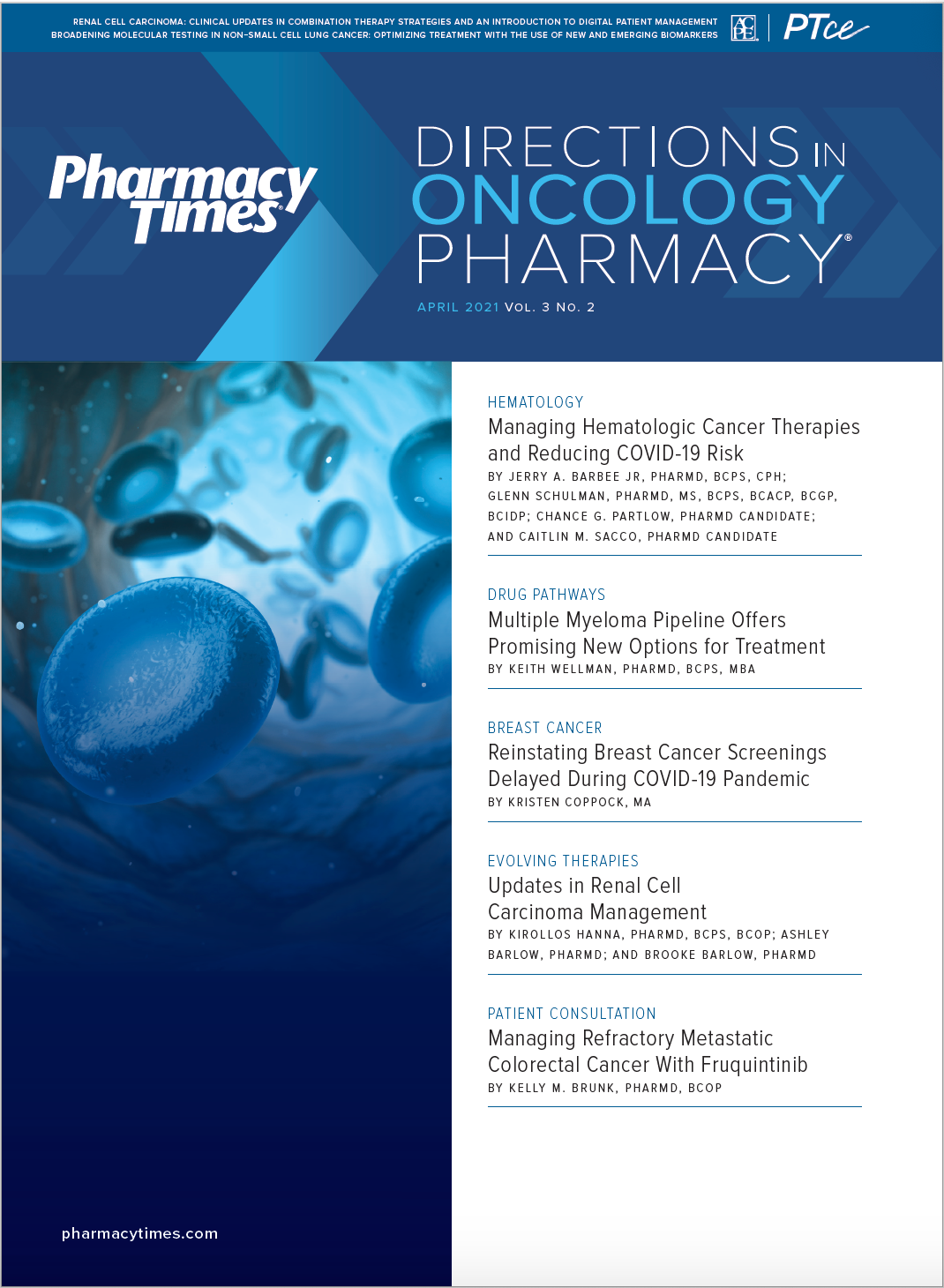Publication
Article
Pharmacy Practice in Focus: Oncology
Novel, Emerging Therapies for HER2+ Metastatic Breast Cancer
Author(s):
Key Takeaways
- Eight FDA-approved HER2-positive-targeted agents include monoclonal antibodies, TKIs, and antibody-drug conjugates, improving survival outcomes for HER2-positive metastatic breast cancer patients.
- Real-world data from France indicate significant improvement in median OS for HER2-positive breast cancer, from 39 months in 2008 to 58 months in 2013.
A review of the efficacy of HER2-positive–targeted agents for metastatic breast cancer.
There are 8 FDA-approved human epidermal growth factor receptor 2 (HER2) positive-targeted agents for metastatic disease. Three are HER2-positive–targeted monoclonal antibodies, 3 are tyrosine kinase inhibitor (TKI) oral agents, and 2 are antibody-drug conjugates, according to Sara A. Hurvitz, MD, FACP, of the University of California, Los Angeles, during a session at the 38th Annual Miami Breast Cancer Conference®.
The efficacy of these approved HER2-positive-targeted agents was demonstrated in the Epidemiological Strategy and Medical Economics (ESME) real-world data analysis presented in an oral session at the European Society for Medical Oncology 2020 Virtual Congress (FIGURE). In France, all women who receive a diagnosis of metastatic breast cancer at cancer centers are enrolled in a registry to follow their outcomes, including overall survival (OS). This extensive record allowed investigators to use these data to assess OS by subtype.
In the analysis, the investigators found that outcomes had not improved in terms of median OS for hormone receptor (HR)-positive breast cancer or triple-negative breast cancer (TNBC) between 2008 and 2017. However, median OS in patients with HER2-positive breast cancer had improved significantly during that time period, increasing from 39 months in 2008 to 58 months in 2013.
“These therapies that we have are so effective that we actually are impacting survival. Notably, the OS associated with this disease subtype is better than the other 2 subtypes now, which is in stark contrast to the outcomes we thought we knew about HER2-positive breast cancer in the pre-trastuzumab era,” Hurvitz said during the session.
Today, the gold standard for first-line treatment of HER2-positive metastatic breast cancer are taxanes and trastuzumab (Herceptin; Genentech) plus pertuzumab (Perjeta; Genentech). For second-line treatment, it is trastuzumab emtansine (Kadcyla; Genentech).
In the third-line setting, however, multiple emerging novel therapies are being introduced into what has become a very crowded space for alternative therapeutic options, according to Hurvitz
Among these options are trastuzumab deruxtecan (Enhertu; Daiichi Sankyo and AstraZeneca); neratinib (Nerlynx; Puma Biotechnology) plus capecitabine; tucatinib (Tukysa; Seagen) plus trastuzumab and capecitabine; and margetuximab-cmkb (Margenza; MacroGenics) plus chemotherapy, with others coming in the pipeline.
“This continues to be an incredibly exciting time for the treatment of HER2-positive breast cancer given all these new agents. [However,] we are challenged to understand how to best sequence these agents, which really will require us to take into account the unique safety profile and efficacy profile of each,” Hurvitz said.
Among the emerging third-line therapies, trastuzumab deruxtecan came onto the market after receiving accelerated approval in December 2019 for the treatment of patients with HER2-positive metastatic breast cancer who had received 2 or more prior therapies. The FDA based this approval on positive data from the single-agent DESTINY-Breast01 (NCT03248492) clinical trial, which assessed pretreated patients with a median of 6 prior lines of therapy.
The cohort during the single-arm phase 2 trial included 184 patients with unresectable and/or metastatic breast cancer who received 5.4 mg/kg of trastuzumab deruxtecan (T-DXd). The investigators observed an overall response rate (ORR) of 61.4% with a median progression-free survival (PFS) of more than 19.4 months; the median duration of response was 20.8 months and median OS was 24.6 months.
“One patient on the study had had 27 prior lines of therapy in the metastatic setting—very heavily pretreated disease. We would get very excited if we saw a 20% objective response rate and a median PFS of 6 months in a patient population like this. But we are blown away to see the objective response rate was actually [above] 61%, with a median PFS reporting of over 16 months. This led to the accelerated approval based on this single-arm, noncomparative study,” Hurvitz said.
However, she drew attention to watching for interstitial lung disease with T-DXd, which was fatal in close to 3% of patients during the study.
“Watching those scans for the development of ground-glass opacities is very important in patients being treated,” she noted.
Another emerging therapy is the TKI neratinib plus capecitabine. The agent received an expanded indication in metastatic disease in February 2020 for patients with advanced and metastatic HER2-positive breast cancer who have received 2 or more prior anti–HER2-based regimens, based on data from the phase 3 NALA trial (NCT01808573).
During the trial, the investigators compared neratinib plus capecitabine with lapatinib plus capecitabine, assessing the coprimary end points of PFS and OS and secondary end points of ORR, duration of response, and safety.
The results demonstrated that the mean PFS of neratinib plus capecitabine was 8.8 months, whereas the mean PFS of lapatinib plus capecitabine was 6.6 months. However, the investigators also observed an increase in occurrence of diarrhea among the neratinib plus capecitabine patient group: 24% of patients experienced grade 3/4 diarrhea vs 13% of patients in the lapatinib plus capecitabine group.
“There was an indication that [central nervous system (CNS)] metastases were reduced in the neratinib arm; however, still about a quarter of patients developed moderate to severe diarrhea with this drug in spite of the lower dose of capecitabine and the use of loperamide,” Hurvitz said. “This is a big limiting factor in the use of this agent.”
She also discussed tucatinib, a unique TKI given its selectivity for HER2, which helps to mitigate the risk of diarrhea for patients. In May 2020, the FDA approved tucatinib for treatment in combination with trastuzumab and capecitabine in patients who have received 1 or more previous HER2-positive-targeted therapies.
The agency’s approval was based on findings from the phase 2 HER2CLIMB trial (NCT02614794), in which 60% of patients had HER2-positive breast cancer and approximately half of patients had a history of CNS metastases that were stable or actively progressing. These patients were randomized to treatment groups with either capecitabine plus T-DXd in combination with either tucatinib or placebo.
The HER2CLIMB investigators found that in the tucatinib group, the PFS rate at 1 year was 33.1%, whereas the PFS at the same period was 12.3%
in the placebo group. At 2 years, the OS for the tucatinib group was 44.9%, whereas for the placebo group it was 26.6%. Additionally, the median OS was 21.9 months for the tucatinib group and 17.4 months for the placebo group.
“At San Antonio [Breast Cancer Symposium], an outcome was presented based on hormone receptor co-expression,” Hurvitz said. “Neratinib, in the extended adjuvant setting, seems to work best in those with hormone receptor co-expression, but in this analysis here, patients benefited regard-
less of whether their hormone receptors were co-expressed. You can see improvements in PFS and OS, regardless of hormone receptor co-expression, and that holds true even in the patient population with brain metastases.”
Another third-line therapy Hurvitz discussed was margetuximab-cmkb plus chemotherapy. The FDA approved the treatment in December 2020 for patients with HER2-positive metastatic breast cancer who have experienced disease progression after receiving 2 or more prior anti-HER2 therapies.
To assess this combination treatment, investigators compared margetuximab-cmkb plus chemotherapy with trastuzumab plus chemotherapy in the phase 3 SOPHIA trial (NCT02492711). The median PFS for margetuximabcmkb plus chemotherapy was found to be 5.8 months, whereas for trastuzumab plus chemotherapy it was 4.9 months.
“Patients who received margetuximab-cmkb had about a 5-week improvement in PFS, which did meet its primary end point. On exploratory subgroup analysis, that benefit did appear to be restricted to patients who were F-carriers, with really no benefit for patients who already have an immune system that tightly binds the Fc receptor,” Hurvitz said. “It will be, I think, utilized more for patients who are F-carriers.”
REFERENCE
Hurvitz S. Novel therapies for HER2+ metastatic breast cancer. Presented at: 38th Annual Miami Breast Cancer Conference®; March 4-7, 2021; Virtual.

Newsletter
Stay informed on drug updates, treatment guidelines, and pharmacy practice trends—subscribe to Pharmacy Times for weekly clinical insights.





